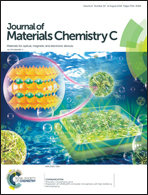Preparation of CsPbBr3@PS composite microspheres with high stability by electrospraying†
Abstract
Cesium lead halide perovskite quantum dots (PQDs) have attracted great interest due to their excellent optical properties. However, PQDs are easily prone to degradation under moisture or polar solvents, which greatly hinders their practical applications. In this communication, ultrastable and highly luminescent CsPbBr3@PS microspheres with a uniform morphology are prepared via a simple and efficient electrospraying method. As a result, the as-prepared CsPbBr3@PS microspheres not only retain the excellent luminescence properties of CsPbBr3 PQDs, but also exhibit superior stability against anion-exchange and water. After being immersed into water for 30 days, the CsPbBr3@PS microspheres still exhibit strong luminescence without any obvious change. When they come into contact with the KI solution, the photoluminescence (PL) intensity of the CsPbBr3@PS microspheres changes very little and the PL wavelength shows no shift after 9 hours. Furthermore, the applications of CsPbBr3@PS microspheres in light-emitting diodes are also investigated to demonstrate their ultrastability in water. This facile and versatile method of protecting PQDs by electrospraying opens new possibilities for applications in an aqueous phase such as cell imaging.



 Please wait while we load your content...
Please wait while we load your content...